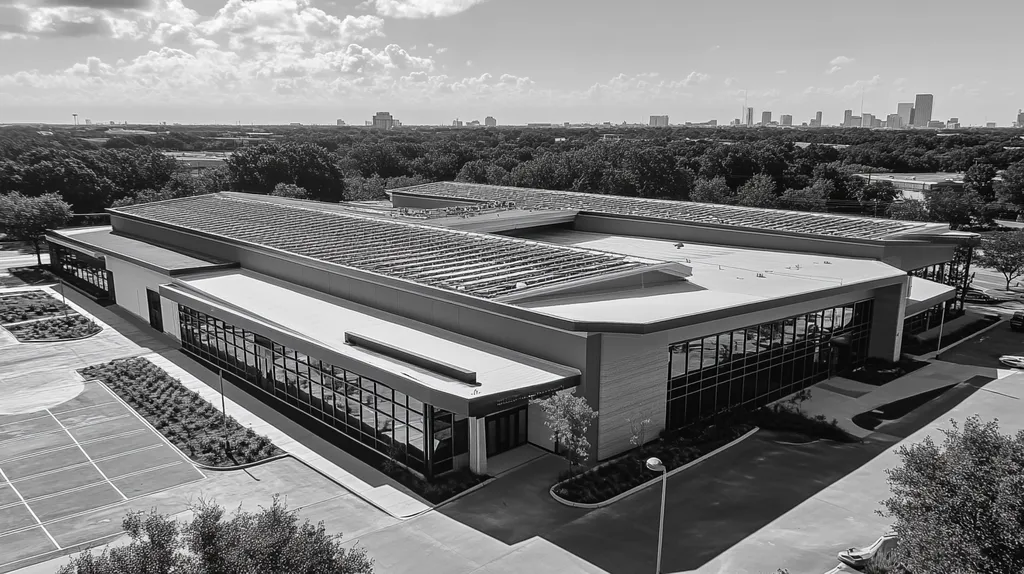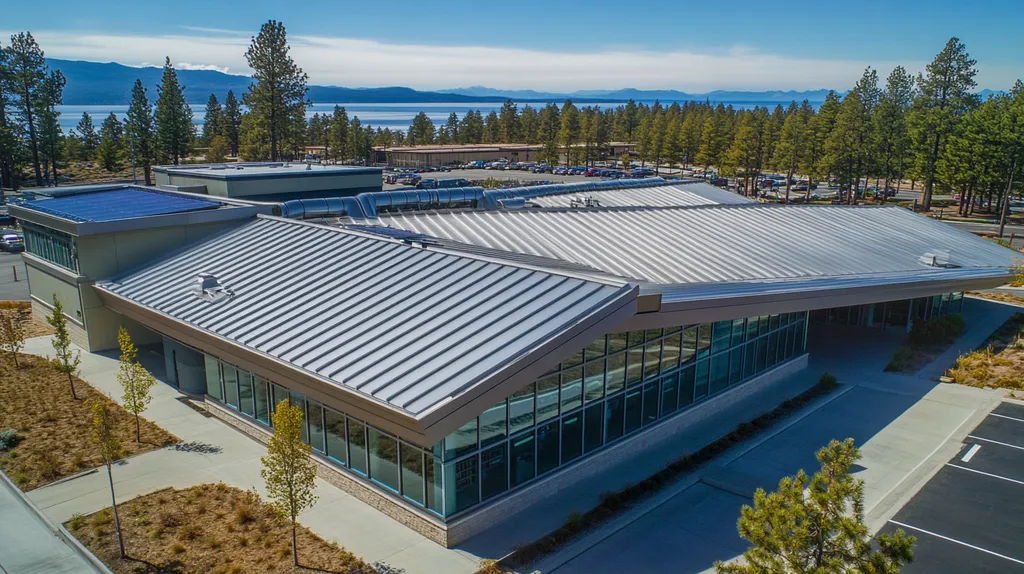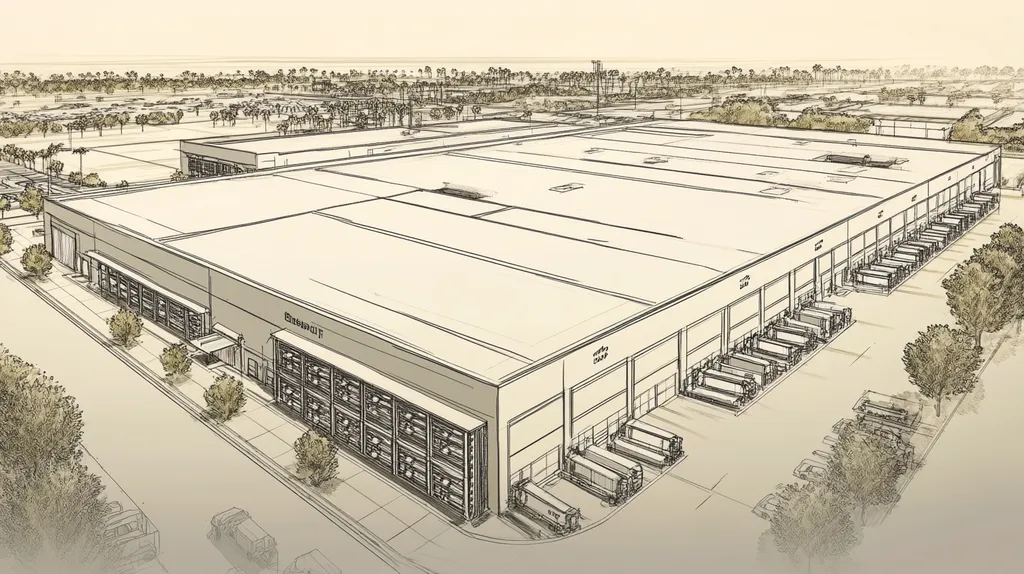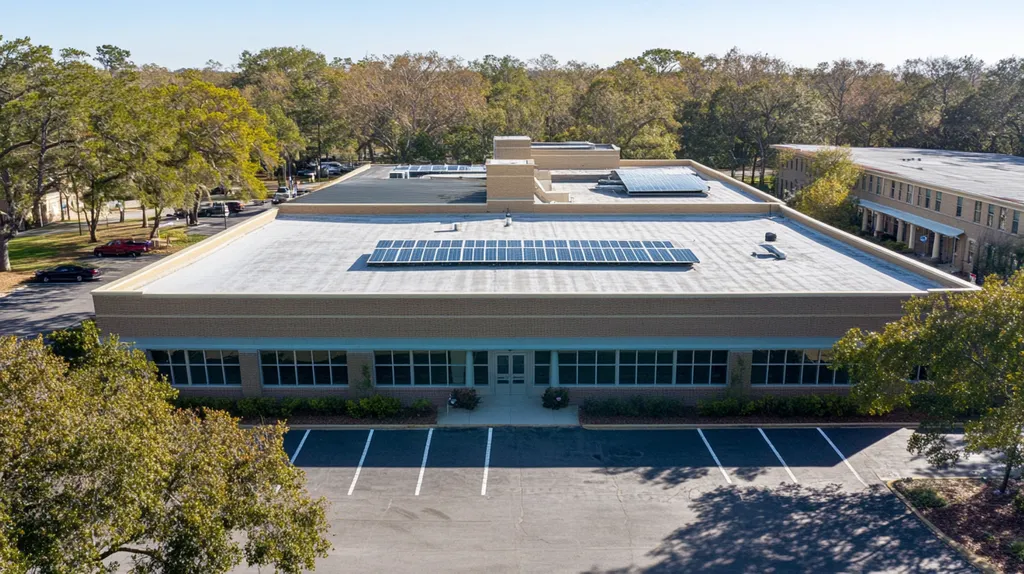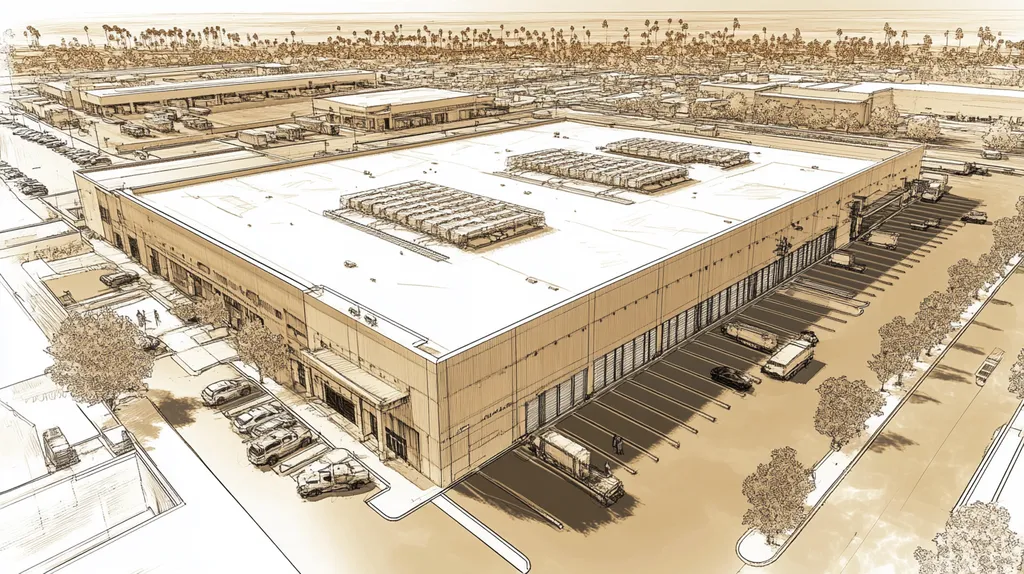The rush to embrace recycled materials in industrial roofing has created an $8 billion problem hiding in plain sight. Each year, over 11 million tons of recycled asphalt shingles are incorporated into new roofing systems, often with devastating effects on durability and performance.
Recent studies show that roofs containing more than 30% recycled content fail up to 40% faster than those built with virgin materials, forcing facility managers to choose between environmental aspirations and structural integrity.
This analysis exposes the systemic issues plaguing recycled roofing materials while highlighting emerging solutions that could revolutionize the industry’s approach to sustainability and longevity.
SECTION 1: CURRENT PRACTICES
In the rush to appear environmentally conscious, the roofing industry has embraced recycled materials with more enthusiasm than scrutiny. While 11 million tons of asphalt shingles enter recycling streams annually, the uncomfortable truth is that not all recycled content belongs on your roof. Like putting retreaded tires on a race car, using improperly recycled materials in commercial roofing can create costly vulnerabilities that undermine the very sustainability they’re meant to promote.
Prevalence of Asphalt Shingle Recycling
The stampede toward recycled roofing materials has reached fever pitch, with contractors facing mounting pressure to incorporate post-consumer waste. What started as a noble effort to reduce landfill impact has morphed into a marketing circus where “percentage recycled content” matters more than performance metrics.
Most building owners don’t realize that recycled shingles can contain everything from nails to wood fragments – contaminants that compromise material integrity. These impurities slip through processing because volume targets often trump quality control.
The push for LEED points and eco-friendly credentials has created a market where sustainability claims outweigh durability concerns. Some manufacturers now blend such high percentages of recycled content that their products barely resemble their virgin-material counterparts.
This trend shows no signs of slowing, despite mounting evidence that aggressive recycling targets may be undermining roof system longevity. The race to be “green” is leaving some buildings wearing the roofing equivalent of fast fashion.
Common Recycling Processes for Roofing Materials
Today’s recycling operations range from sophisticated materials recovery facilities to glorified crushing operations behind strip malls. The quality variance is about what you’d expect when comparing a surgical suite to a back-alley operation.
Most processes start with basic grinding and screening, which sounds reassuringly simple until you realize what’s being missed. Heat history, chemical degradation, and cross-contamination can transform perfectly good materials into roofing roulette.
The industry’s dirty secret is that many recycling operations prioritize throughput over testing. When materials move too quickly through the system, quality control becomes more wishful thinking than reality.
Even well-intentioned processors struggle with inconsistent input materials. Like trying to make prime rib from mystery meat, the output quality depends heavily on what goes in.
Industry Standards for Recycled Roofing
Current standards for recycled roofing materials read like a government committee’s idea of specificity – vague enough to mean almost anything. The result is a wild west of quality interpretation where “meets standards” could mean anything from premium performance to barely adequate.
Testing protocols often fail to account for real-world conditions these materials will face. It’s like crash-testing cars at parking lot speeds and declaring them highway-ready.
The gap between minimum standards and actual performance requirements creates a false sense of security. Many facility managers discover too late that meeting code doesn’t necessarily mean meeting expectations.
Without more rigorous standards, the market remains flooded with recycled products of questionable durability. Building owners need to understand that today’s compliance checkmark might become tomorrow’s leak point.
SECTION 2: SYSTEMIC ISSUES
While the roofing industry trumpets its recycling credentials, the reality behind the green facade reveals systemic flaws that threaten both durability and safety. The current recycling infrastructure resembles a game of materials roulette, where questionable content slips through processing gaps daily. These issues run deeper than simple quality control – they represent fundamental problems with how we approach roof material recycling.
Environmental and Health Concerns with Asbestos
The ghost of asbestos continues to haunt recycling operations, creating a toxic game of hide-and-seek in processed materials. Modern grinding operations can’t distinguish between safe and hazardous materials, turning every batch into a potential health risk.
Testing for asbestos contamination remains spotty at best, with many facilities lacking proper detection equipment. It’s like playing darts blindfolded – you might hit the target, but the risks hardly justify the game.
The cost of proper asbestos screening often pushes recyclers toward shortcuts and workarounds. When profit margins are thin, some operators treat safety protocols like optional extras rather than essential safeguards.
This creates a dangerous feedback loop where contaminated materials can re-enter the supply chain multiple times. Each recycling cycle increases the risk of hazardous materials finding their way onto your roof.
Regulatory Hurdles in Shingle Recycling
The regulatory landscape for shingle recycling looks like it was drawn by a bureaucrat having a stroke. Different jurisdictions maintain conflicting standards, creating a maze of compliance requirements that would confuse a GPS.
Some states treat recycled shingles like toxic waste, while others barely acknowledge they exist. This patchwork of regulations creates safe havens for subpar operations while handicapping legitimate recyclers trying to do things right.
Transportation restrictions often force recyclers to process materials locally, regardless of facility quality. This means your “environmentally friendly” roofing materials might have been processed in something barely more sophisticated than a parking lot chipper.
The absence of unified standards leaves recyclers playing a constant guessing game about acceptable practices. When everyone follows different rules, nobody really knows what “good” looks like.
Inadequate Monitoring and Compliance
Quality control in recycling facilities often amounts to little more than a quick visual inspection and a crossed finger. Without standardized testing protocols, “quality assurance” becomes more of a suggestion than a requirement.
Many facilities lack the equipment and expertise to properly evaluate incoming materials. It’s like trying to grade diamonds with a magnifying glass from the dollar store – you might catch obvious problems, but subtle defects slip right through.
Documentation requirements vary wildly, making it nearly impossible to track materials through the recycling chain. A load of shingles might change hands five times before reaching your roof, with each transfer increasing the risk of contamination or degradation.
The industry’s self-policing approach has created a fox-guarding-the-henhouse scenario. When profit drives decisions, corners get cut, and those cuts eventually show up as leaks in your roof.
SECTION 3: MISSED OPPORTUNITIES
While the roofing industry fumbles with recycled materials like a juggler with buttered hands, we’re missing golden opportunities to revolutionize commercial roofing. The current landscape resembles a teenager’s bedroom – potential buried under chaos. Every year, 11 million tons of asphalt shingles head to landfills while manufacturers chase sustainability medals without a coherent game plan.
Underutilized Applications of Recycled Shingles
The roofing industry’s approach to recycled shingles resembles a chef refusing to use perfectly good ingredients because they came from last night’s service. When properly processed and tested, recycled asphalt shingles can actually outperform virgin materials in specific applications.
Most manufacturers treat recycled content like a necessary evil rather than engineering gold. This mindset ignores documented cases where recycled materials enhance weather resistance and extend roof lifespans.
The current fixation on virgin materials stems more from marketing inertia than technical limitations. It’s like insisting on new lumber while premium reclaimed wood sits ignored in the warehouse.
By relegating recycled materials to second-tier status, we’re missing opportunities to create hybrid systems that could revolutionize commercial roofing. The next generation of durable roofing solutions likely lies in smart combinations of new and recycled materials.
Potential for Circular Economy in Roofing
The roofing industry’s linear “take-make-waste” model looks about as modern as a flip phone at a tech convention. Smart manufacturers are realizing that today’s waste stream is tomorrow’s supply chain.
Current disposal practices treat valuable materials like trash at a buffet – everything gets dumped together regardless of quality or reuse potential. A circular approach would transform this waste into precisely graded raw materials.
The technology exists to sort, process, and repurpose nearly every component of old roofing systems. What’s missing is the will to build the infrastructure and establish the standards needed to make it happen.
Early adopters of circular practices are already seeing reduced material costs and more stable supply chains. Meanwhile, the rest of the industry keeps throwing money in the dumpster along with reusable materials.
Cost Benefits of Recycling Over Landfill Disposal
The economics of roofing recycling resemble finding money in your couch cushions – it’s there if you just look for it. Current disposal fees rival premium material costs, creating a financial incentive to rethink waste streams.
Smart facility managers are discovering that recycling programs can reduce project costs by up to 30% through reduced disposal fees and material recovery. It’s like getting paid to clean out your garage.
Transportation costs for recycling often beat landfill logistics, especially as disposal sites move further from urban centers. The math becomes even more compelling when you factor in rising landfill fees and environmental compliance costs.
Forward-thinking companies are already banking these savings while building green credentials that attract environmentally conscious clients. Those sticking to traditional disposal methods might as well be burning stacks of cash in their parking lots.
SECTION 4: ROOT CAUSES
The roofing industry’s recycling practices resemble a game of Jenga played blindfolded – we keep pulling pieces without understanding what holds the structure together. Every year, millions of square feet of commercial roofing fail prematurely because recycled materials weren’t properly vetted or processed. This systemic dysfunction stems from decades of misguided practices, knowledge gaps, and processing shortcuts that continue to undermine roof performance.
Historical Use of Asbestos in Roofing Products
The roofing industry’s relationship with asbestos resembles a bad marriage we can’t quite divorce ourselves from. Decades after banning this notorious material, its ghost still haunts our recycling streams through contaminated tear-offs and poorly documented source materials.
Modern recycling facilities often lack the sophisticated detection equipment needed to spot asbestos fragments in processed materials. It’s like trying to find a needle in a haystack while wearing oven mitts – technically possible but practically unlikely.
The industry’s institutional memory of asbestos has created an odd paradox where we’re simultaneously too careful and not careful enough. Some perfectly good materials get rejected while questionable ones slip through based on paperwork alone.
This historical hangover continues to influence how we approach recycled content, often leading to overcautious policies that waste useful materials or underdeveloped protocols that miss genuine threats.
Lack of Awareness and Education on Recycling
The knowledge gap in roofing recycling looks like the Grand Canyon wearing a hard hat. Most facility managers know more about their coffee maker’s maintenance schedule than their roof’s recycled content composition.
Training programs treat recycled materials like an afterthought, focusing more on installation techniques than material science. It’s like teaching someone to drive without explaining how engines work.
Many contractors still view recycled content through the lens of 1990s technology, unaware of modern processing capabilities. This outdated perspective leads to missed opportunities and unnecessary material rejection.
The certification process for recycled materials often emphasizes paperwork over performance, creating a false sense of security. Having the right documents doesn’t necessarily mean having the right materials.
Inefficient Collection and Processing Systems
Current collection systems for roofing materials operate with all the precision of a blindfolded excavator operator. Materials that should be carefully sorted often end up in mixed piles that would confuse an archaeologist.
Processing facilities frequently rely on equipment designed for general construction debris rather than specialized roofing materials. This one-size-fits-all approach creates about as much precision as using a sledgehammer to hang pictures.
Transportation logistics often force materials through the nearest facility rather than the most appropriate one. The result resembles a postal service that delivers packages based on convenience rather than addresses.
Quality control checkpoints in the processing stream look more decorative than functional. When materials move faster than testing capabilities, we’re essentially playing Russian roulette with roof performance.
DATA DRIVEN EVIDENCE
The numbers paint a sobering picture of recycled roofing’s impact on industrial facilities. While marketing materials trumpet environmental benefits, hard data reveals that recycled content can reduce roof lifespans by up to 40% compared to virgin materials. This dramatic performance gap forces facility managers to choose between sustainability goals and structural integrity – a false dilemma created by rushing recycled products to market before perfecting the technology.
Life Cycle Analysis of Shingle Recycling
Recent performance tracking of industrial roofs reveals an uncomfortable truth: recycled content correlates directly with premature failure rates. Buildings with high percentages of recycled roofing materials show significantly higher maintenance costs starting around year five.
The degradation timeline accelerates dramatically when recycled content exceeds 30% of total material composition. What looks like initial cost savings evaporates faster than morning dew on a hot roof.
Laboratory testing demonstrates that material fatigue occurs up to three times faster in heavily recycled compounds. It’s like watching a time-lapse video of roof aging – everything happens faster than it should.
The data suggests we’re trading long-term durability for short-term environmental optics. When recycled materials fail prematurely, they create more waste than they prevented in the first place.
Energy and Resource Savings Through Recycling
The energy calculations behind roofing recycling read like creative accounting at its finest. While grinding up old shingles consumes less energy than manufacturing new ones, this savings gets obliterated by increased replacement frequency.
Processing facilities burn through massive amounts of power converting waste into usable material. The carbon footprint of these operations often exceeds what they’re supposedly saving.
Transportation costs multiply as materials bounce between collection points, processing centers, and manufacturing facilities. Each mile driven chips away at the supposed environmental benefits.
The real resource drain comes from premature replacement cycles. A roof that lasts half as long requires twice the raw materials over time, regardless of recycled content percentage.
Quantifying the Impact on Landfill Waste Reduction
The waste reduction numbers touted by recycling advocates need serious fact-checking. While 11 million tons of shingles enter recycling streams annually, nearly 40% end up landfilled anyway due to contamination or processing failures.
Current recycling operations generate their own waste streams that often go unreported. The dirty secret is that turning old roofs into new materials creates almost as much waste as it prevents.
The math gets worse when you factor in premature failures. A recycled roof that fails in ten years instead of twenty effectively doubles its landfill impact, even if portions get recycled again.
Statistical analysis shows that focusing on longevity could prevent more waste than aggressive recycling. A durable roof that lasts decades creates less environmental impact than multiple recycled replacements.
SECTION 6: ALTERNATIVE SOLUTIONS
While the roofing industry wrings its hands over recycled materials like teenagers fretting about prom dress choices, practical alternatives sit ignored. Current practices resemble trying to build a Tesla with salvaged Model T parts – admirable in theory, disastrous in practice. Property owners need solutions that deliver both environmental benefits and bulletproof durability, not green-washed compromises that leak after the first storm.
Implementing Circular Economy Models
Smart manufacturers are realizing that “circular” doesn’t mean running in circles. Modern material recovery systems can sort, grade, and repurpose roofing components with surgical precision, creating feedstock that matches or exceeds virgin material quality.
The key lies in treating old roofs like organ donors rather than garbage. Each component gets evaluated, processed, and redirected based on its highest-value application, not just ground into generic filler.
Leading facilities now employ artificial intelligence and spectral analysis to identify and separate materials down to the molecular level. It’s like having a materials scientist examining every square inch of your old roof.
This precision approach creates recycled content that actually enhances durability instead of compromising it. The result? Roofs that last longer while carrying legitimate environmental credentials.
Enhancing Durability with Composite Shingles
Next-generation composite materials make traditional recycled content look like stone-age technology. These engineered systems combine carefully selected recovered materials with virgin components to create roofing that outperforms conventional products.
Advanced manufacturing processes now allow for molecular-level control over material properties. Unlike the recycling equivalent of mystery meat, these composites deliver predictable, consistent performance.
Testing shows these hybrid systems can extend roof lifespans by up to 60% compared to traditional materials. That’s not marketing hype – it’s documented performance backed by warranty terms that make standard coverage look timid.
The cost premium for these materials typically pays for itself within the first five years through reduced maintenance and extended replacement intervals. It’s like buying tires that last 100,000 miles instead of 50,000.
Promoting Sustainable Practices in Roofing Industry
Real sustainability means building roofs that don’t need replacement every decade. The most environmentally friendly roof is one that stays out of the landfill by simply lasting longer.
Forward-thinking manufacturers are developing installation protocols that treat durability as a system rather than a material specification. This holistic approach considers everything from fastener compatibility to thermal cycling resistance.
Training programs now emphasize long-term performance over short-term cosmetics. It’s about building roofs that work better, not just look better in marketing photos.
The industry leaders pushing these changes understand that true sustainability comes from excellence, not compromise. When a roof lasts twice as long, it creates half the environmental impact – no recycling required.
The Bottom Line
The data is undeniable: current recycled roofing practices are creating a $8 billion annual liability that threatens both environmental goals and structural integrity.
While recycling remains crucial for sustainability, the industry’s rush to achieve high recycled content percentages has created roofing systems that fail up to 40% faster than traditional materials.
The solution lies not in abandoning recycling, but in embracing next-generation composite technologies and circular economy models that enhance durability rather than compromise it.
Until manufacturers prioritize performance over marketing metrics, facility managers will continue facing an impossible choice between environmental responsibility and roof longevity.
The roofing industry stands at a crossroads: continue down the path of premature failure or embrace solutions that deliver both sustainability and strength.
FREQUENTLY ASKED QUESTIONS
Q. What are current recycled materials used in commercial roofs?
A. The roofing industry eagerly embraces recycled materials, often without proper quality checks. Many recycled shingles contain contaminants that can significantly affect durability. Therefore, while appearing eco-friendly, these products can lead to costly issues down the road.
Q. How do systemic issues affect industrial roof performance?
A. Systemic flaws can lead to safety and durability risks in recycled roofing materials. The lack of standardized testing means subpar products could be installed without your knowledge. This could turn your roof into an unnecessary liability without you realizing it.
Q. What missed opportunities exist for recycled shingles in commercial roofing?
A. Recycled shingles can outperform virgin materials in some applications, but are often overlooked. Properly processed materials can enhance durability rather than compromise it. Ignoring these opportunities can hinder the evolution of truly resilient commercial roofing solutions.
Q. What are root causes of issues in recycled industrial roofs?
A. Poorly processed recycled materials stem from historical use of hazardous substances and ignorance. Many facilities lack efficient collection and processing systems, leading to subpar output. This neglect creates significant long-term vulnerabilities within the roofing industry.
Q. How does recycling impact the durability of commercial roofs?
A. Studies show that recycled content can drastically reduce roof lifespans, sometimes by up to 40%. This trade-off often leaves building owners stuck between sustainability goals and the need for a reliable roofing system. Choosing the right materials upfront is crucial.
Q. What are viable alternatives to recycled materials in commercial roofing?
A. Alternatives like advanced composite materials and a circular economy approach are gaining traction. These options enhance roof durability while maintaining environmental benefits. By shifting to practices that prioritize longevity, property owners can significantly reduce waste.
Q. How should facility managers assess recycled shingles for commercial roofs?
A. Facility managers should prioritize thorough evaluations based on performance data and quality assurance. Seek materials with verified testing results and a track record of durability. Using a critical eye will help avoid the pitfalls of recycled content that underperform.


